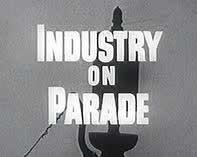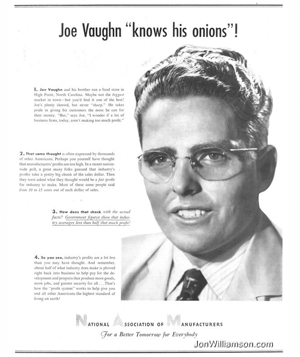The Ad Council’s work, though extensive, was not isolated. With the Joint Committee’s coordination, NAM and the Chamber of Commerce, together with thousands of business and ‘educational’ organizations, undertook programs on a scale that rivalled that of the Advertising Council. The free market message even appeared in comic books and on matchbox covers.
NAM President Claude Putnam argued that ‘to sell—to resell, if you will—to free Americans the philosophy that has kept us and our economy free’ was a ‘dire  necessity’. NAM enrolled hundreds more industrialists throughout the country in the campaign to reshape public opinion. The Opinion Research Corporation had identified ten ‘ignorance areas that made a great deal of trouble for a good many companies’ including the size of industry’s profits; the share of profits going to workers; ownership of industry; the role of competition in reducing prices; and ‘how capital earns its keep.’
necessity’. NAM enrolled hundreds more industrialists throughout the country in the campaign to reshape public opinion. The Opinion Research Corporation had identified ten ‘ignorance areas that made a great deal of trouble for a good many companies’ including the size of industry’s profits; the share of profits going to workers; ownership of industry; the role of competition in reducing prices; and ‘how capital earns its keep.’
In its materials NAM addressed these concerns and also opposed unions, price controls, government spending and taxes. It produced films about how economic freedom and individual freedom were linked, about the benefits of wages paid by companies, and about the value of individual initiative and hard work. Millions of people viewed NAM motion pictures with titles such as ‘The Price of Freedom’—an alarmist film on ‘creeping socialism’. Some two and a half million people watched NAM films in 1948 alone.
Churches were targeted through plant tours and conferences for clergy. NAM distributed millions of pamphlets (18 million were distributed between 1946 and 1950 to employees, students and community leaders) and supplemented its radio programs with a television series ‘Industry on Parade’ showcasing individual companies and demonstrating the benefits they offered to individuals, the community and the nation. It spent millions on ‘paid advertisements, news releases, speeches, posters, leaflets, and magazines’. Thousands of papers and journals received material. These efforts were augmented by newspapers, which ran NAM material for free. Despite all this activity, NAM did not become a household name because it sought not to be identified with the materials.
 NAM sought to make use of business leaders and the respect they already wielded in the towns and cities to promote its goals with an Industry Leaders program which it launched in 1947. It recognised that if these businesspeople were given the right messages and trained in how to deliver them to best effect, then they would be more effective in shaping public opinion than NAM spokespeople. They would be ‘better champions of the American way’.
NAM sought to make use of business leaders and the respect they already wielded in the towns and cities to promote its goals with an Industry Leaders program which it launched in 1947. It recognised that if these businesspeople were given the right messages and trained in how to deliver them to best effect, then they would be more effective in shaping public opinion than NAM spokespeople. They would be ‘better champions of the American way’.
NAM ran motivational conferences for some 9000 selected business people in the first two years of the program. At these conferences business people received a manual which explained the ‘American Individual Enterprise System’ and also source material for speeches and panel discussions directed at the local community. NAM told them how to sell free enterprise and how to appeal to the heart and to lead people ‘through a thinking process’. These businessmen became the ‘missionaries’ for free enterprise going to meetings such as the YMCA, YWCA, Rotary, Exchange, Parent-Teacher Associations, Women’s groups and Church groups to spread the word. In the process they also increased their own influence in the community.
NAM also targeted what it termed ‘thought leaders’ who were influential in shaping community opinion and encouraged local business people to do the same. These ‘thought leaders’ included educators, clergy, professionals, local officials and women’s leaders. It produced publications aimed at particular groups such as teachers or women’s club leaders. Each publication was distributed to tens of thousands of people. Information packages, with speeches, sample news releases, and advice on public speaking, were distributed to club directors. NAM held town meetings to which hundreds of clergy, educators, youth leaders and other ‘thought leaders’ came to be re-energised with the ‘traditional concepts of American liberty’.
In 1949 the US Chamber of Commerce launched programs to provide training and resources to local chambers and in 1954 it introduced Economic Discussion Groups with similar goals to NAM’s Industry Leaders Conferences. Some fifteen hundred groups of businessmen met weekly for eighteen weeks to discuss materials supplied by the Chamber